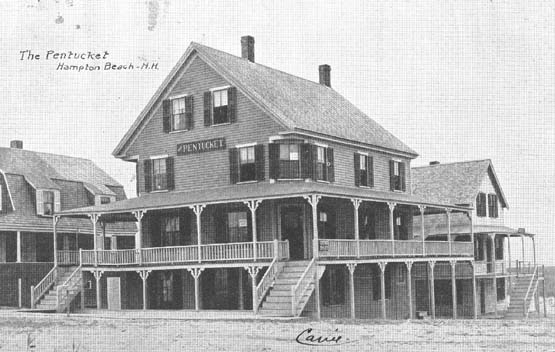Worst Conflagration Since the Ocean House Was Burned in 1885
The Hamptons Union, Thursday, November 16, 1911

(Postmark is August 8, 1911)
[Post Card photo not in original newspaper article.]
The most serious fire conflagration which Hampton Beach has experienced since the Ocean House and nearly a score of small buildings were burned in May, 1885, occurred Monday night when four cottages and a hotel were destroyed. Fortunately at the time of the fire the wind was blowing directly out to sea. Had the wind been from the south or southwest, and had it been blowing with the force that characterized it the night before, Hampton Beach would now be a mass of blackened and smoldering ruins. As it is the property loss is about $14,000, which falls upon the owners of the burned buildings and the insurance companies.
The fire started in the Priscilla, corner J Street and Ocean Avenue, four blocks south of the Casino, owned by W. F. Thayer of Haverhill. When discovered a little before six o’clock the flames were bursting through the roof and the whole upper part of the building was on fire. The alarm was given by Warren Drew and others, and the shouts of men and the tinkle of telephone bells soon summoned a large number to the scene.
From the Priscilla the fire communicated itself to the Josephine, owned by Ira J. Webster of Haverhill, and named in honor of his wife: and from the Josephine spread to the Stanwood, another of Mr. Thayer’s cottages. Beyond the Stanwood stood the Pentucket, a summer hotel purchased only a few months before by Mrs. E. M. Fogg of Manchester. This in turn was swept away by the flames, which were only halted in their march northward by I Street. To the south they crossed J street and completely gutted the Hiawatha, owned by Emery J. Smith of Haverhill.
Both of the Beach hose companies were soon on the scene and did good work. Three streams were thrown on the fire. The preasure was weak and the streams were not as powerful as could be desired. The chemical fire wagon came down from Hampton Village, the horses on the gallop, Thomas Cogger at the reins, and aided greatly in protecting adjoining property. Captain Smart and his men from the life saving station rendered efficient service; and the fire ladders, under the direction of such veteran firefighters as L. C. Ring and F. J. O’Dea, waged a winning battle with the devouring element.
Help was proffered from other places, but was not needed. The local men demonstrated that they were amply able to cope with the situation. Amesbury sent down a line of hose, but it was not connected. By eight o’clock was under control.
The fire loss is about $14,000, distributed as follows: W. F. Thayer, Haverhill, $5,000; Ira J. Webster, Haverhill, 2,500; Mrs. E. M. Fogg, Manchester, $5,000; Emery J. Smith, Haverhill, $1,500. This is about two-thirds covered by insurance.
The only accident that comes to our notice is that which happened to Harry I. Noyes, the builder, who was on the roof of the Pentucket, fighting the flames, when he slipped and fell to the ground below, a distance of some fifteen feet. No bones were broken, but the fall severely strained the ligaments of his right foot, and will confine him to the house for several days.
Sensational reports are in circulation as to the origin of the fire, but the most probable explanation is that it caught from the electric wires.
Saturday and Sunday were very warm, causing the wire to stretch; than came the cold snap on Sunday night and Monday, which suddenly contracted them. The high wind which prevailed fifteen miles an hour must have caused the wires to chafe and the continued abrasion may have worn off some of the insulation. This theory is favored by the fact that the fire followed the turning on of the electric currant Monday afternoon by about the space of time that would have required for it to start and get underway.
Had the fire been of incendiary origin it would have been more likely to have come in the night. Firebugs work while honest men sleep.
The fire demonstrated three things: (1) The need of some fire alarm system at the beach. (2) The need of a night man at the pumping station to keep the pressure up to the highest point when a fire is discovered. (3) The fact that the Hampton fire department can do a good job if it has half a chance.
The second Pentucket fire
The Hamptons Union, Thursday, June 6, 1912
The Pentucket, a four story house owned by Mrs. Etta M. Fogg of Manchester, was damaged by fire about six o’clock this morning, from an unknown cause. The Pentucket was burned last fall, with several other houses adjoining, and the fire this morning destroyed the new structure just built on the site. Mrs. Fogg had moved in her furniture and stored it on the top floor yesterday, and it was on that floor that the fire originated, perhaps by a spark from a smoker’s pipe which smouldered, and later broke into flames. The upper part of the building and contents were a total loss, but adjoining property was saved by excellent work of the fire company. It was insured in the Continental.

[Post Card photo not in original newspaper article.]